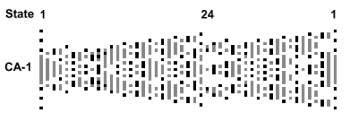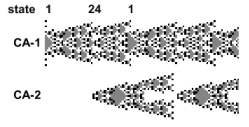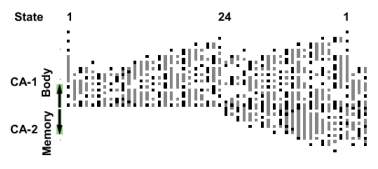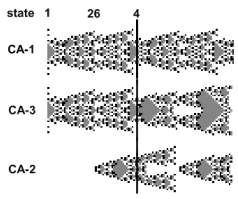 |
Memory
 |
 |
The vector may be viewed as a worm which grows and shrinks, Following mitosis it forms a bud which grows and elongates. CA-2 is actually appended to CA-1, and this elongated worm is the proliferon. In the image below the first vectors (states) are aligned along the abscissa. When memory is formed it is attached to the worm from below.
 |
Two representations
Proliferon histories are depicted here in two ways, conjoined
and separated. The first is a vector that
simulates a worm, and the second is a mapping which is more convenient
for studying proliferon behavior.
Each state of the cycling vector is also it's memory. It specifies (remembers) how to
proceed to the next state. While in the stem process each of the 46 states does not change, in
transient processes, states may be modified (differentiation), creating
different memories. Initially
the proliferon consists of the stem process, with its fixed memory set. In order to expand its memory, CA-1 enters mitosis (at state = 26) and grows
a memory process (CA-2). As CA-2 grows it displays new memories (states).
When reaching state = 46, CA-2 dies, a new bud is formed, and memory grows
again. CA-1 may bud at any state.
This emerging memory may control other processes, like in the example below. Initially CA-1 created two transient processes: CA-3, and a memory process (CA-2), which started budding at state = 26. When CA-1 entered its state = 4 it activated the respective CA-2 state in order to modify CA-3 structure. At state = 4 the proliferon consisted of three conjoined vectors (states): {CA-1 + CA-3 + CA-2}.
 |
While computer memory stores bits, worm memory stores actions, and its bit configuration is meaningless. This is meant also for real worms which lack brains. Their memories are stored in their processes, called here Wisdom of the Body (WOB). Humans are endowed also with a brain, which stores images, and structure. Yet their major memory bulk is in the WOB and never reaches consciousness..